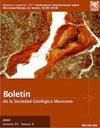Fossil relatives of extant parasitic crustaceans from the Mesozoic of Europe
IF 0.4
4区 地球科学
Q4 GEOLOGY
引用次数: 0
Abstract
The fossil record of Isopoda includes remains of presumed parasites. Among the fossils which have been discussed as potential parasites are those termed as Urda Münster, 1840. Some of these fossils have been discussed as possibly related to an extant group of parasites, Gnathiidae Leach, 1814. The type species of Urda – Urda rostrata Münster, 1840 – is herein interpreted as a close relative of the group Gnathiidae, based on the shared occurrence of a number of apomorphic features. This is with Urda punctata (Münster, 1842) herein being interpreted as a junior subjective synonym of U. rostrata. However, not all of the fossils associated with the name Urda can safely be identified as close relatives of Gnathiidae. Moreover, it is unclear whether the extinct species, which can be identified as close relatives of U. rostrata and Gnathiidae form a monophyletic group, as we could not identify an autapomorphy for a natural group Urda. A new species of close relatives of Urda rostrata and Gnathiidae – Urda buechneri n. sp. – is formally described based on µCT image data. Palaega suevica Reiff, 1936 and Palaega kessleri Reiff, 1936 are found to be subjective synonyms and are re-interpreted as Urda suevica n. comb. – a species closely related to U. rostrata. Due to the documented destruction of the holotype, a herein figured fossil specimen is designated as the neotype of Urda suevica. Palaega? stemmerbergensis Malzahn, 1968 is also interpreted as a close representative of U. rostrata and herein treated as Urda stemmerbergensis n. comb. Another already formally described species – Eobooralana rhodanica gen. et comb. nov. – is interpreted as a more distant relative, which is likely to be closer related to other extant species of Isopoda than those within Gnathiidae. For three species there are not enough characters preserved to interpret them as closely related to U. rostrata and Gnathiidae: Urda? liasica Frentzen, 1937 nom. dub. (type material destroyed, description insufficient for proper diagnosis), Urda? moravica Remeš, 1912 and Urda? zelandica Buckeridge and Johns, 1996.欧洲中生代现存寄生甲壳类动物的化石亲缘关系
等足目动物的化石记录包括推测的寄生虫遗骸。在被讨论为潜在寄生虫的化石中,有被称为Urda Münster的化石,1840年。其中一些化石被认为可能与现存的一组寄生虫有关,Gnathidae Leach,1814年。Urda的模式种——Urda rostrata Münster,1840——在这里被解释为Gnathidae群的近亲,基于许多变形特征的共同出现。这是因为Urda punctata(Münster,1842)在这里被解释为U.rostrata的初级主观同义词。然而,并不是所有与Urda这个名字相关的化石都能被安全地确定为Gnathidae的近亲。此外,目前尚不清楚这些已灭绝的物种是否形成了一个单系群,因为我们无法确定一个自然群Urda的自变形。根据µCT图像数据,正式描述了一种新的喙孔虫和Gnathidae的近亲——布氏孔虫(Urda buechneri n.sp.)。Palaega suevica Reiff,1936和Palaega kessleri Reiff,被发现是主观同义词,并被重新解释为Urda suevica n.comb一种与花腹蛛有密切亲缘关系的物种。由于记录在案的正模标本的破坏,本文中的一个化石标本被指定为苏氏Urda suevica的新模标本。Palaega?stemmerbergensis Malzahn,1968也被解释为U.rostrata的密切代表,在本文中被视为Urda stemmerbergensis.comb。另一个已经被正式描述的物种——依乌拉那rhodanica gen.et comb。nov.–被解释为一个更遥远的亲缘关系,与Gnathidae内的物种相比,它可能与其他现存的异足目物种关系更密切。对于三个物种,没有足够的特征被保存下来,无法将它们解释为与花蟾科和Gnathidae有密切关系:Urda?liasica Frentzen,1937年化名。授予称号(类型材料已销毁,描述不足以进行正确诊断),Urda?moravica Remeš,1912和Urda?zelandica Buckeridge和Johns,1996年。
本文章由计算机程序翻译,如有差异,请以英文原文为准。
求助全文
约1分钟内获得全文
求助全文
来源期刊
CiteScore
1.40
自引率
12.50%
发文量
34
审稿时长
50 weeks
期刊介绍:
The Boletín de la Sociedad Geológica Mexicana is a completely free-access electronic journal published semi-annually that publishes papers and technical notes with its main objective to contribute to an understanding of the geology of Mexico, of its neighbor areas, and of geologically similar areas anywhere on Earth’s crust. Geology has no boundaries so we may publish papers on any area of knowledge that is interesting to our readers.
We also favor the publication of papers on relatively unfamiliar subjects and objectives in mainstream journals, e.g., papers devoted to new methodologies or their improvement, and areas of knowledge that in the past had relatively little attention paid them in Mexican journals, such as urban geology, water management, environmental geology, and ore deposits, among others. Mexico is a land of volcanos, earthquakes, vast resources in minerals and petroleum, and a shortage of water. Consequently, these topics should certainly be of major interest to our readers, our Society, and society in general. Furthermore, the Boletín has been published since 1904; that makes it one of the oldest scientific journals currently active in Mexico and, most notably, its entire contents, from the first issue on, are available online.

 求助内容:
求助内容: 应助结果提醒方式:
应助结果提醒方式:


